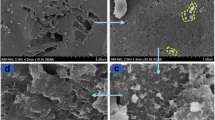Abstract
The adsorption of uranium (VI), cesium and strontium ions from aqueous solutions onto a commercial activated carbon obtained by physical activation of coconut shell has been studied in batch systems. In particular the adsorption of uranium, studied as a function of contact time and metal ion concentration, followed pseudo-first-order kinetics. Equilibrium adsorption data were fitted by Langmuir and Freundlich isotherm models and the maximum adsorption capacity of the activated carbon resulted to be 55.32 mg/g. The study showed that the considered activated carbon could be successfully used for uranium adsorption from aqueous solutions. Feasibility of cesium and strontium adsorption onto the same activated carbon has been also investigated. Results showed that no affinities with both of these ions exist.















Similar content being viewed by others
Notes
Note: besides the OH− ion, uranyl is able to coordinate NO3 − (surely present in solution because uranyl nitrate was adopted for experiments) and CO3 2− (which may come from CO2 in air when reacting with water); anyway, simulation runs with MINTEQA2 at concentrations of interest, showed that molar concentrations of nitrates and carbonates complexes result absolutely negligible, so they were assumed not relevant.
References
Kutahyali C, Eral M (2010) Sorption studies of uranium and thorium on activated carbon prepared from olive stones: kinetic and thermodynamic aspects. J Nucl Mater 396(2–3):251–256
Marzal P et al (1996) Cadmium and zinc adsorption onto activated carbon: influence of temperature, pH and metal/carbon ratio. J Chem Technol Biotechnol 66(3):279–285
Silem A et al (1992) Adsorption of organic matter from a wet phosphoric acid using activated carbon: batch contact time study and linear driving force models. Canad J Chem Eng 70(3):491–498
Mellah A, Chegrouche S, Barkat M (2006) The removal of uranium(VI) from aqueous solutions onto activated carbon: kinetic and thermodynamic investigations. J Colloid Interface Sci 296(2):434–441
Benedict M, Pigford TH, Levi HW (1981) Nuclear chemical engineering, 2nd edn. Mac Graw Hill, New York
Egawa H et al (1994) Recovery of uranium from seawater. 15. Development of amidoxime resins with high sedimentation velocity for passively driver fluidized bed adsorbers. Ind Eng Chem Res 33(3):657–661
Sakaguchi T, Nakajima A (1986) Recovery of uranium by immobilized polyhydroxyanthraquinone. Sep Sci Technol 21(5):519–534
Kutahyali C, Eral M (2004) Selective adsorption of uranium from aqueous solutions using activated carbon prepared from charcoal by chemical activation. Sep Purif Technol 40(2):109–114
Mahramanlioglu M (2003) Adsorption of uranium on adsorbents produced from used tires. J Radioanal Nucl Chem 256(1):99–105
Stamberg K, Venkatesan KA, Vasudeva Rao PR (2003) Surface complexation modeling of uranyl ion sorption on mesoporous silica. Colloid Surf A 221(1–3):149–162
Jung Y et al (2008) Preparation of functionalized nanoporous carbons for uranium loading. Colloid Surf A 313–314:292–295
Starvin AM, Rao TP (2004) Solid phase extractive preconcentration of uranium (VI) onto diarylazobisphenol modified activated carbon. Talanta 63(2):225–232
Song KC et al (1997) Adsorption characteristics of radiotoxic cesium and iodine from low-level liquid wastes. J Radioanal Nucl Chem 223(1–2):199–205
Wang T et al (2008) Removal of cesium ions from aqueous solution by adsorption onto local Taiwan laterite. J Hazard Mater 160(2–3):638–642
Mizera J et al (2007) Sorption of cesium, cobalt and europium on low-rank coal and chitosan. Water Res 41(3):620–626
Alarifi A, Hanafi HA (2010) Adsorption of cesium, thallium, strontium and cobalt radionuclides using activated carbon. J At Mol Sci 1(4):292–300
Chegrouche S, Mellah A, Barkat M (2009) Removal of strontium from aqueous solutions by adsorption onto activated carbon: kinetic and thermodynamic studies. Desalination 235(1–3):306–318
Shawabkeh RA, Rockstraw DA, Bhada RK (2002) Copper and strontium adsorption by a novel carbon material manufactured from pecan shells. Carbon 40(5):781–786
Gratuito MKB et al (2008) Production of activated carbon from coconut shell: optimization using response surface methodology. Bioresource Technol. 99(11):4887–4895
Lopez-Ramon MV et al (1999) On the characterization of acidic and basic surface sites on carbons by various techniques. Carbon 37(8):1215–1221
Mullet M et al (1999) A simple and accurate determination of the point of zero charge of ceramic membranes. Desalination 121(1):41–48
Song X et al (2010) Surface modification of coconut-based activated carbon by liquid-phase oxidation and its effects on lead ion adsorption. Desalination 255(1–3):78–83
Lide DR (1993–1994) Handbook of chemistry and physics, 74th edn. CRC, London
Song KC et al (1997) Simultaneous removal of the radiotoxic nuclides Cs-137 and I-129 from aqueous solution. Sep Purif Technol 12(3):215–227
Acknowledgments
The authors gratefully acknowledge the “Micro and Nanostructured Materials Lab” of NEMAS – Department of Energy – Politecnico di Milano for SEM analyses. Special thanks to M. Giola, M. Giorgi and A. Mantegazza for their support in the experimental activity.
Author information
Authors and Affiliations
Corresponding author
Rights and permissions
About this article
Cite this article
Caccin, M., Giacobbo, F., Da Ros, M. et al. Adsorption of uranium, cesium and strontium onto coconut shell activated carbon. J Radioanal Nucl Chem 297, 9–18 (2013). https://doi.org/10.1007/s10967-012-2305-x
Received:
Published:
Issue Date:
DOI: https://doi.org/10.1007/s10967-012-2305-x




